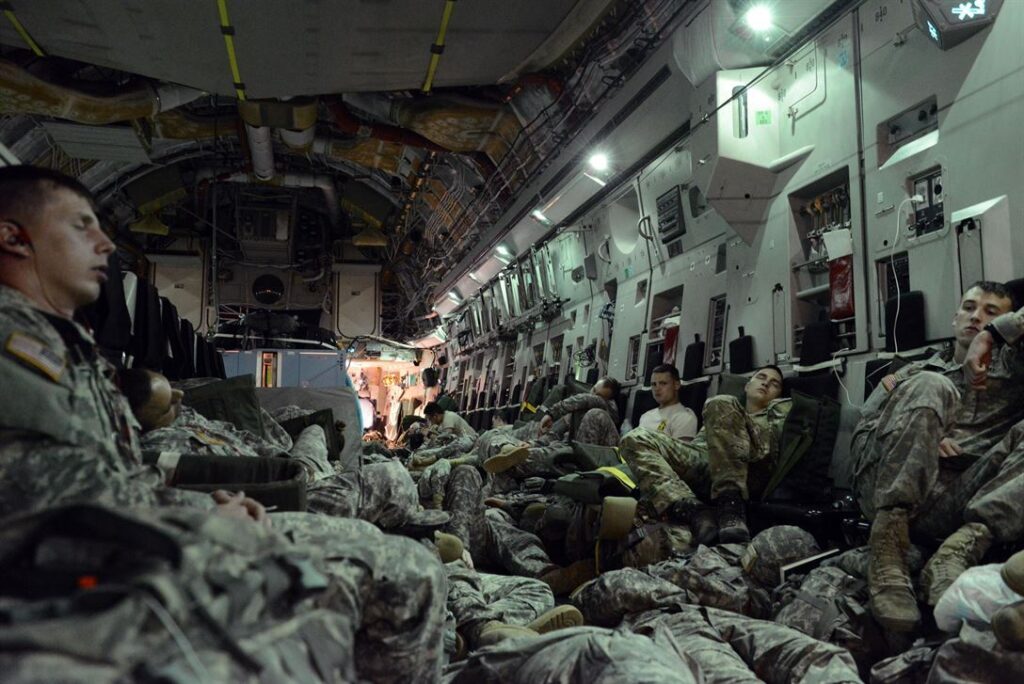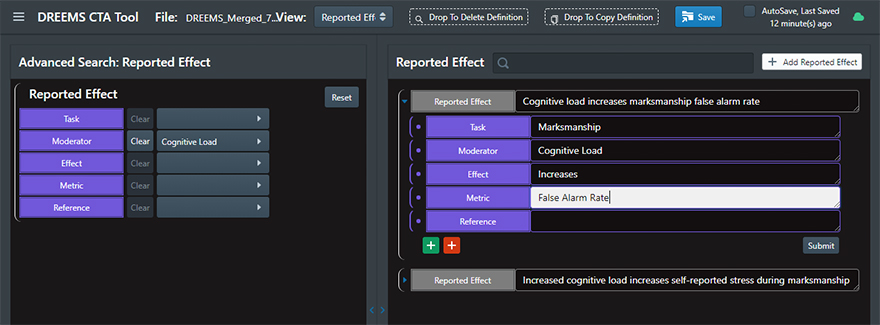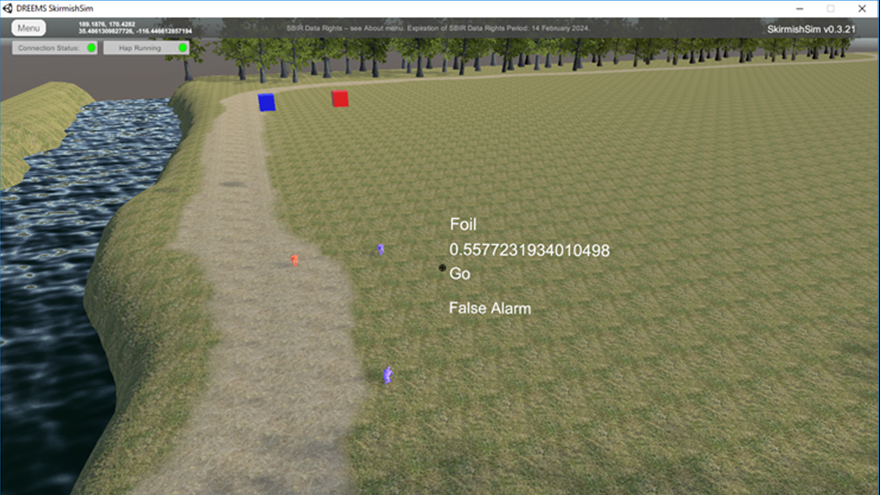DREEMS
Helping analysts understand
how stressors impact Warfighters
DREEMS helps model impacts of stressors on Warfighter performance
With DREEMS, mission planners, analysts, and researchers can understand and model the impact of stressors on a Warfighter’s performance. Their insights can ultimately improve Warfighter lethality, survivability, and operational effectiveness on the battlefield.

Paratroopers on a 17-hour flight trying to get some pre-jump rest on the aircraft. (Image: Defense.gov)
Stressors, such as heavy gear, sleep deprivation, and temperature extremes, are an expected and common part of a Warfighter’s life on the battlefield. Without rest or support, though, these stressors can cripple an effective unit, even on the easiest terrain. The effects of stressors multiply exponentially with rough ground and bad weather—the more hills a Warfighter must climb and the worse the weather, the faster they will tire. Similarly, carrying too much weight with too little sleep also accelerates exhaustion. This performance degradation can result in serious, costly mistakes and slower reaction times, which can mean the difference between life and death for a Warfighter.
“The Army is working with us to enhance our DREEMS approach to ensure troops operate at peak performance. DREEMS lets them deeply understand the effects of fatigue, stress, and other moderators on cognitive and physical performance.”
– Dr. Peter Weyhrauch, VP, Human-Centered AI
DREEMS Overview
The Need
Exhaustion and other stressors can cause Warfighters to make riskier decisions and result in a loss of psychomotor control—two elements essential for operating weapons and electronic equipment. Analysts need a way to represent and assess the cognitive effects of fatigue on decision making and physical activities. Understanding and studying the impact of stressors on a Warfighter’s performance can improve US Army operational effectiveness.
The Solution
Our DREEMS approach combines best-of-breed cognitive modeling elements and learning components into a unified methodology that represents and analyzes fatigue and other stressors and their influence on task performance.
We partnered with Professor Frank Ritter of the Pennsylvania State University, Professor Christopher Dancy of Bucknell University, and Dr. Victor Middleton to develop the DREEMS approach.
The Benefit
With DREEMS, military analysts can assess performance degradation more accurately, yielding insights that improve Warfighter decision making and increase unit effectiveness. DREEMS-developed models are designed to integrate into existing simulations and tools.
DREEMS helps model impacts of stressors on Warfighter performance
With DREEMS, mission planners, analysts, and researchers can understand and model the impact of stressors on a Warfighter’s performance. Their insights can ultimately improve Warfighter lethality, survivability, and operational effectiveness on the battlefield.

Paratroopers on a 17-hour flight trying to get some pre-jump rest on the aircraft. (Image: Defense.gov)
“The Army is working with us to enhance our DREEMS approach to ensure troops operate at peak performance. DREEMS lets them deeply understand the effects of fatigue, stress, and other moderators on cognitive and physical performance.”
– Dr. Peter Weyhrauch, Division VP of Human-Centered Intelligent Systems
Stressors, such as heavy gear, sleep deprivation, and temperature extremes, are an expected and common part of a Warfighter’s life on the battlefield. Without rest or support, though, these stressors can cripple an effective unit, even on the easiest terrain. The effects of stressors multiply exponentially with rough ground and bad weather—the more hills a Warfighter must climb and the worse the weather, the faster they will tire. Similarly, carrying too much weight with too little sleep also accelerates exhaustion. This performance degradation can result in serious, costly mistakes and slower reaction times, which can mean the difference between life and death for a Warfighter.
Helping analysts model stressors faced by Warfighters
How does fatigue from carrying a heavy load all day degrade decision-making speed and accuracy during a room clear? Does physical exhaustion reduce situational awareness and degrade the quality of threat assessment? Exhaustion and other stressors can cause Warfighters to make riskier decisions and result in a loss of psychomotor control—two elements essential for operating weapons and electronic equipment.
Analysts need a way to represent and assess the cognitive effects of fatigue on decision making and physical activities. To provide a basic understanding of the causes and effects of stressors and supporting data (that is, to characterize these stressors), we teamed with Professor Frank Ritter of Pennsylvania State University, Professor Christopher Dancy of Bucknell University, and Dr. Victor Middleton to develop Dynamic Representation for Evaluating the Effect of Moderators and Stress on Performance (DREEMS) for the US Army.

Paratroopers on a 17-hour flight trying to get some pre-jump rest on the aircraft. (Image: Defense.gov)

Warfighter agents powered by the data from the CTA Tool using the Hap architecture interact within our 3D simulation environment, SkirmishSim.
Our research approach uses cognitive reasoning and modeling so analysts can better understand how stressors may impact Warfighters’ decision making during specific tasks. The tools developed under DREEMS help analysts characterize fatigue and other stressors, evaluate cognitive and physiological task performance, and develop methodologies for understanding, analyzing, and predicting how fatigue and other stressors arise and affect a Warfighter’s performance.
DREEMS augments numerous military planning and visualization systems, including military modeling and simulation (M&S). It combines best-of-breed cognitive modeling elements and learning components into a unified methodology that represents and analyzes fatigue and other stressors and their influence on task performance. DREEMS-developed models are designed to integrate into existing simulations and tools, and they allow military analysts to assess performance degradation more accurately, yielding insights that improve Warfighter decision making, increase unit effectiveness, and strengthen US Army operations.
Contact us to learn more about DREEMS and our other capabilities.
This material is based upon work supported by the US Army Command Center, Aberdeen Proving Ground, Natick Contracting Division ACC-APG-NCD under Contract No. W911QY-17-C-0009. Any opinions, findings and conclusions or recommendations expressed in this material are those of the author(s) and do not necessarily reflect the views of the US Army Command Center, Aberdeen Proving Ground, Natick Contracting Division ACC-APG-NCD. The appearance of U.S. Department of Defense (DoD) visual information does not imply or constitute DoD endorsement.
